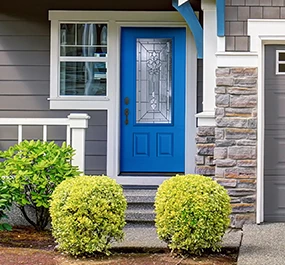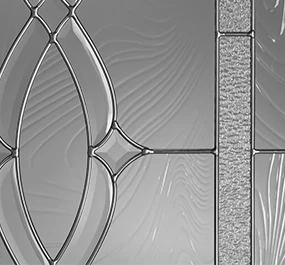As the point of entry in a home, a secure front door is one of the most important ways to keep your household safe. While a fiberglass door is a great foundation when ensuring safety in your home, a simple way to ramp up your home security is through a quality exterior door lock. From features such as keyless entry to touchscreen control pads, a great lock can offer superior security and peace of mind when leaving the house.
What to consider when choosing a lock
There are a variety of considerations when you’re choosing a lock. From design, to lock grade, to special features, it all comes down to what works best for your home’s security. Some of today’s most advanced locks employ access logs, keypads, alarms, strike plates, and even voice or fingerprint recognition.
Lock Type
Just as there are different door designs, there are different designs of locks to keep your home safe. It might sound complex, but choosing a type of lock is surprisingly simple if you know what you want in terms of home security. Let’s take a look at a few types of locks.
Single cylinder locks
A single cylinder lock is one of the most common locks used to secure your home. This type of lock operates from the inside by turning a thumb knob and from the outside with a key. This makes it easy to quickly secure your home from the inside.
Double cylinder locks
Double cylinder locks start out similar to its single cylinder relative, but its similarities end at opening from the outside with a key. Instead, these locks are keyed on both sides, meaning they only open with a key on the exterior and the interior. These are a great option for doors with glass panes, as anyone attempting to break in would be unable to reach inside and unlock the deadbolt.
Smart locks
With today’s technological advances, it’s no surprise this has extended to home security. Smart locks connect to your home’s Wi-Fi, which then sends information to your smartphone. Some are even operated by voice control or with fingerprint recognition. If you’re wondering how secure these locks are, don’t worry—these locks are often used with a deadbolt for the best possible front door security.
Vertical locks
Vertical locks are the most common secondary locks sold in the US. These locks feature a vertical bolt which extends through a set of rings, securing your door. While they are found on both commercial and residential doors, these types of locks are often found in hotel doors and apartment complexes.
Quality
Locks are issued ratings by the American National Standards Institute (ANSI), which measures each lock’s strength and durability. The ANSI grade is a factor that decides how secure your lock is.
Grade 1
Grade 1 is the most secure type of lock, with the ability to withstand 10 strikes of 75 lbs of force. Grade 1 has been considered for a long time to be a heavy-duty, industrial lock used mostly within industrial and commercial settings, but it’s become more common to find them within residential homes. If you’re looking for a Grade 1 lock, it’s important to make sure it’s a qualified ANSI Grade 1, and not a lock with Grade 1 “features”.
Grade 2
Grade 2 locks are the residential standard, with the ability to withstand 5 strikes of 75 pounds of force. While it may sound necessary to go with a Grade 1 lock for your home, many residential homes employ Grade 2 locks, as they’re designed to prevent most forced entry attempts. As Grade 2 locks are sometimes even used for light commercial use, they’re a great choice for keeping your house safe.
Grade 3
Grade 3 is considered the lowest quality acceptable according to ANSI standards, and it can generally withstand 2 strikes of 75 pounds of force. Grade 3 locks are often used in basic residential settings; while it will still offer basic security, it’s unlikely to deter a persistent intruder.
Features
For even more ease of use and access and an even greater sense of security, you can pick up locks with a variety of special features.
Reinforced strike plate
A strike plate is the metal plate that attaches to the inside of the door frame. As one of the most important aspects of your home security, some homeowners opt for reinforced plates, rather than inexpensive ones that might give or bend easily in an attempted break-in.
Access logs
Another great feature for peace of mind when it comes to home security are access logs. This gives homeowners the option to install smart door locks which provide information on who entered your house and when.
Alarm system
If you’re serious about security, you might opt for a smart lock with a built-in alarm system. An alarm system is one of the best ways to deter intruders, and is especially useful on a lock as the entry door is often the first point of entry for an intruder.
Rekeying
For homeowners who struggle to remember where they’ve misplaced their keys, rekeying is a great feature as it eliminates the need to replace your lock each time you lose a key and prevents entry with old keys.
Universal handling
If your interest in features is more focused on accessibility and ease of access, universal handling gives homeowners the ability to install locks that are universal for both right-handed and left-handed doors.
Improve your home security with Plastpro
While choosing a lock can be a big decision, it’s important to remember that your lock is only as good as your exterior door is. For the most secure home possible, you might consider replacing your door if it’s getting a little old, or even switching out a traditional wood door for a superior fiberglass door.
Plastpro offers a variety of designs and options, allowing any homeowner to get the look they want while enhancing durability and door security. With a durable outer shell and high-density, polyurethane foam core, our doors are built to stand up to anything—from severe weather to intruders. Where locks are concerned, Plastpro’s fiberglass doors feature a full-length lockblock, which provides additional holding strength for any lock of your choosing.
Why is a full-length lockblock so key? Traditionally a fiberglass door’s lockblock is only built to surround the immediate 18- 20” vicinity of the lock, and the rest of the space above and below is filled in with foam. However, our lumber runs the full vertical length of the door, providing additional rigidity and support that keeps the door from being kicked in by an intruder or blown in by severe weather. Additionally, the LVL material will absorb bendable stress without snapping, unlike a wood material.
To find a dealer near you, check out Plastpro’s Where to Buy page today.



